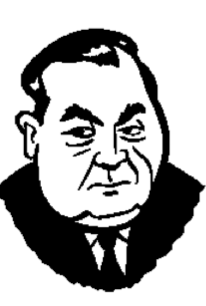LEE TRACY
1898–1968
 Had God, in His wisdom, decided to sculpt man from cork instead of clay, and then set this bobbing Adam down not in some suburban garden but rather in the deco concrete jungles of the Hollywood back lot, circa ’32, and had the premiere human met his maker’s stuffed-shirt, post-apple query “Where art thou?” not with stammered excuses and panicked crotch concealment but rather a flurry of fingers, stabbing and fluttering, the better to underline the insouciance of his reply (beginning “Who wants to know?”), if this had come to pass, how much happier would we, the degenerate descendants, be today—not least because this hypothetical progenitor would surely have stumped the snake on the reverse con and wrung its skin for oil?
Had God, in His wisdom, decided to sculpt man from cork instead of clay, and then set this bobbing Adam down not in some suburban garden but rather in the deco concrete jungles of the Hollywood back lot, circa ’32, and had the premiere human met his maker’s stuffed-shirt, post-apple query “Where art thou?” not with stammered excuses and panicked crotch concealment but rather a flurry of fingers, stabbing and fluttering, the better to underline the insouciance of his reply (beginning “Who wants to know?”), if this had come to pass, how much happier would we, the degenerate descendants, be today—not least because this hypothetical progenitor would surely have stumped the snake on the reverse con and wrung its skin for oil?
Yea, such a one there was, and named they him Lee Tracy. Along with Cagney, Tracy embodied the very fruit and flower of Depression American manhood, perfectly adapted to survive amidst the era’s flux of fortunes. His knobby nose, receding chin, and wheedling voice made him an unlikely leading man, but for one brief, glorious period he was: witness in wonder his turns in Blessed Event and The Half-Naked Truth (both 1932).
Tragically, his movie career arc ended in a premature splash. On a bender after wrapping his role in Viva Villa!, he peed off a hotel balcony just as a division of the Mexican army happened to be parading below. Shunted to the sidelines after the ensuing “international incident,” he scraped by in programmers for a few years (some optimist thought a film about a postal detective might spawn a series, but really) before returning to the Broadway that birthed him, where his legacy remained untainted by urine. A sad story with a happy-ish ending, for it would be hard to conceive a better final film role than the one he got, as the retiring president in 1964’s The Best Man. Iris out on the great man in ill health but conniving unto death, a paradise regained.
EUGENE PALLETTE
1889–1954
 The ’30s were a great decade for the heftier player, celebrating differences of mass in a way unthinkable today, from the graceful expanse of Oliver Hardy to the walking infarction that was Eugene Pallette.
The ’30s were a great decade for the heftier player, celebrating differences of mass in a way unthinkable today, from the graceful expanse of Oliver Hardy to the walking infarction that was Eugene Pallette.
With the body of a warehouse and a basso-profundo voice that seemed to emerge, with loud echo, from somewhere beneath the floor he stood on, Pallette was often typed as wealthy capitalists, but his weight was seldom explicitly referred to. What we got instead was the perpetual umbrage machine, the tetchiness of a man who knows for certain that his waistline is about to be mentioned or at least...
You have reached your article limit
Sign up for a digital subscription and continue reading all new issues, plus our entire archives, for just $1.50/month.
Already a subscriber? Sign in




